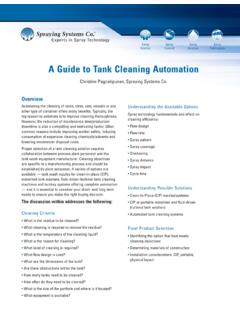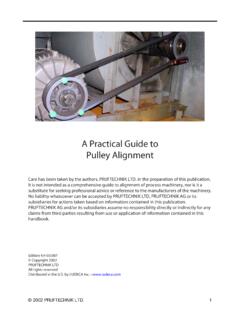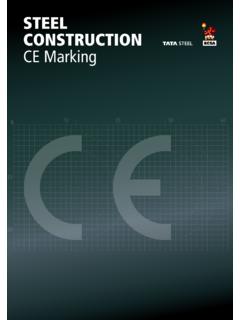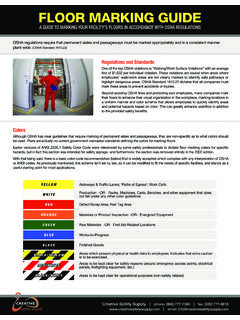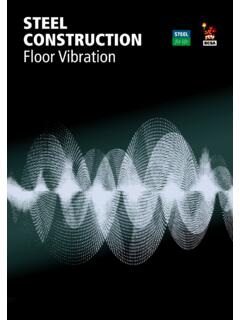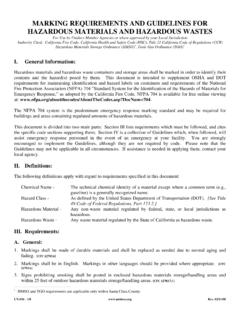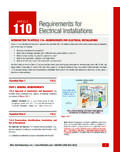Transcription of 5S Floor Marking Color Standard - Plant Services
1 Government Regulations & Industry StandardsWhile several OSHA regulations dictate that permanent aisles and passageways must be clearly marked, there are no current government-mandated or even widely accepted industry standards that proscribe what colors to use when Marking floors. Some suppliers inappropriately reference the ANSI Safety Color Code Standard as a guide for selecting colors for Floor Marking . Earlier versions of the Standard did include Color specifications for specific types of safety hazards and equipment.* However, the specifications were removed from the 2002 edition of the Standard and no longer represent ANSI recommended best practices. Moreover, Section of the Standard explicitly states that the specifications are intended for use on safety signage.
2 Thus does not provide a sound basis for formulating a Color Standard for Floor information resources also reference OSHA Standard 29 CFR , Safety Color Code For Marking Physical Hazards. However, these specifications are extremely limited in scope. The Standard simply states that red should be used to identify fire protection equipment, emergency stop devices, and containers holding dangerous materials. Yellow should be used for Marking physical hazards such as striking against, stumbling, falling, tripping and caught-in-between hazards. Again, the Standard is not designed to provide guidance on Color usage when Marking Color Recommendations For Floor MarkingThe following recommendations comply with the OSHA Standard noted above, but go further to provide a comprehensive Color scheme that helps to visually delineate work areas and pathways, as well as to identify at a glance designated storage locations for materials, product, tools and Color scheme intentionally limits the number of colors to promote easy learning and memorization.
3 It can be modified as needed in order to suit the specific operational priorities, processes and characteristics of individual facilities. ANSI makes the following recommendations relating to Color usage in safety signage. These specifications have been omitted from more recent updates of the Standard and no longer represent ANSI recommended best practices. Safety Red: for identifying danger and stop (examples: flammable liquid containers, emergency stop buttons, fire protec-tion equipment). Safety Orange: for identifying intermediate level (warning) hazards and hazardous parts of machinery (examples: machine parts which may cause cut, crush or other injuries, moving parts such as gears, pulleys and chains). Safety Yellow: for identifying caution (examples: physical hazards such as tripping, falling, striking against and caught-in-between hazards, storage cabinets for flammable or combustible materials, containers for corrosives or other unstable materials).
4 Safety Green: used for identifying emergency egress and first aid or safety equipment such as safety deluge showers, gas masks, and stretchers. Safety Blue: for identifying safety information used on informational signs and bul-letin boards; also has specific applications in the railroad area to designate warnings against the starting, use of, or move-ment of equipment that is under repair or being worked on. Safety Black, White and Yellow, or combinations thereof, shall be used to designate traffic or housekeeping markings. 5S Floor MarkingColor Floor Marking Color StandardUseAs the border Color for:YellowAisleways, traffic lanes and work cellsWhite Equipment and fixtures (workstations, carts, Floor stand displays, racks, etc.) not otherwise Color codedBlue, green and/or blackMaterials and components, including raw materials, work-in-progress and finished goodsOrangeMaterials or product held for inspectionRedDefects, scrap, rework, and red tag areasRed & whiteAreas to be kept clear for safety/compliance reasons ( , areas in front of electrical panels, firefighting equipment, and safety equipment such as eyewash stations, safety showers and first aid stations.)
5 Black & whiteAreas to be kept clear for operational purposes (not related to safety and compliance)Black & yellowAreas that may expose employees to special physical or health hazards. Use as few colors as possible. This will make it easier for employees to remember the intended meaning of each Color and reduce the number of Floor Marking products that must be kept in inventory. Color coding workcell and equipment borders. Some companies choose to mark equipment locations using the same Color employed for aisleways and work cell boundaries. This has the benefit of simplicity. However, consideration should also be given to the fact that the overall layout of lanes and sectors within the Plant is made more visually clear when different colors are used for these purposes.
6 Color coding material storage areas. Use the same border Color for all material storage areas unless there is an important reason for differentiating between raw materials, work in progress and finished goods. As an alternative, consider using one border tape Color in conjunction with different colored labels to visually distinguish between the various material types. Color coding non-material storage fixtures. Floor markings for fixtures such as racks that hold raw materials, work in progress or finished goods should be Color coded in green, blue and/or black. Otherwise use white or gray to mark the location of all other fixtures. Color coding areas to be kept clear for safety and compliance. Some companies use red or red-and-white stripes in front of firefighting equipment, and green or green-and-white stripes in front of safety equipment.
7 For simplicity sake, however, we recommend standardizing on one Color for all applications where the intent is to keep the area in front of equipment clear for safety or compliance reasons. That said, we also recommend that the firefighting and safety equipment itself - as well as any associated wall signage - be Color coded using red and green, respectively, to enhance visibility and facilitate easy location of the equipment from a distance. Color coding areas in front of electrical panels. Under this Standard , red and white should also be used to mark the Floor in front of electrical panels. Some facilities use black and yellow to indicate the presence of an electrical hazard, but the primary purpose of the Marking is to keep the area in front of the panel clear.
8 Danger labels should be displayed on the outside of the panels to warn employees of potential shock and arc flash hazards. Color coding operational keep clear areas. Use black and white Marking to indicate that an area should be kept clear for operational reasons, such as ensuring sufficient clearance for forklifts. As objects without a home tend to naturally congregate in open areas, employ black and white Marking to discourage the use of open Floor space for unintended purposes. Color coding hazardous areas or equipment. Black and yellow striped Marking should be used as a border around a ny area or piece of equipment where employees may be inadvertently exposed to a special hazard. For example, use black and yellow borders around flammable or combustive material containers.
9 The intent of the black and yellow border is to indicate that special caution should be exercised when entering and working in the area. Floor Marking Guidelines: ExamplesAisleways & traffic lanes (yellow) Work cells(yellow) Equipment (white)Material storage areas (green, blue and/or black) QA inspection (orange)Defects/scrap/rework (red)Keep clear operational (black/white)Keep clear safety (red/white) Hazard area (black/yellow) ToughStripeTM Floor Marking TapeThe most durable adhesive-based Floor Marking solution on the market! Test-proven to withstand forklift traffic better than the leading competitors Easy application system makes laying smooth, straight lines a one-person job High gloss surface looks great and cleans up easily with common cleanser Comes in a variety of colors and shapes, including prespaced dashes and dots Also available as Floor signs and as label media for use in Brady label printersToughStripeTM material also runs through Brady GlobalMark 2 & BMP71TM printers, allowing you to create durable Floor labels onsite and on demand!
10 See next page for more information on Brady label & Workbench Marking Supplies Self-adhesive vinyl sheets and tapes designed for use on tool boards, work benches, storage shelves and other non- Floor surfaces. Stick securely to a wide range of surface types Won t peel, crack or fade when exposed to common cleansers, solvents or sunlightFor more information on Brady s visual workplace solutionsvisit: create tool shadows to exact size and shape using Brady s shadow vinylCreate durable rectangular borders using Brady Marking tape and corner marksBrady Label PrintersBrady label printers are essential tools for creating a visual workplace. Designed for industrial use, both printers and the labels created on the printers are designed to withstand harsh industrial labels together with 5S borders ensures that items are easily returned to their proper 5S Marking KitsEverything you need to 5S your facility in one kit!
